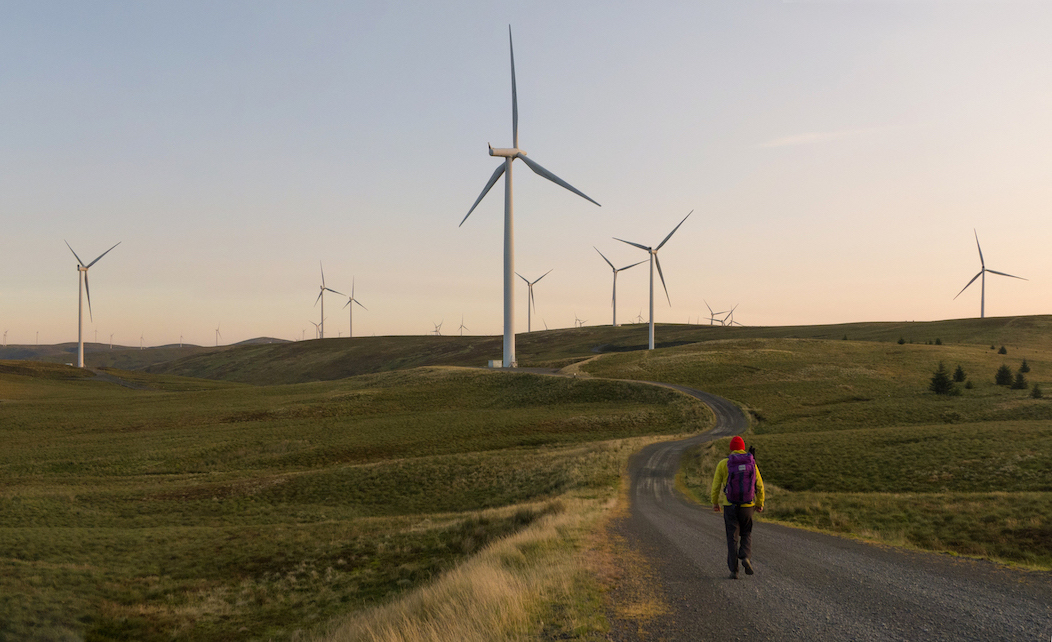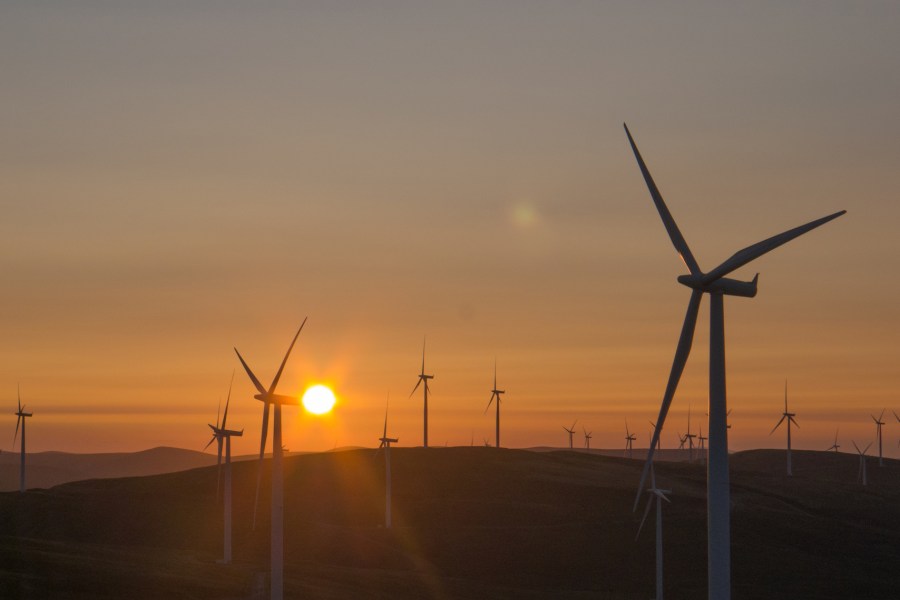Walkers and windfarms often don’t mix well – but for Ronald Turnbull, the urgency of the climate crisis means it’s a sacrifice we have to make.
Header image: Sunrise over the Clyde Wind Farm. Photo: Ronald Turnbull
When a new windfarm comes along, our natural reaction as walkers is to say something like: “well, we’re all in favour of renewable energy. But this particular windfarm is in the wrong place”. And the next windfarm proposal? Also in the wrong place.
One of the first windfarms in Scotland was on Windy Standard, in Galloway between Carsphairn and Sanquhar. In case you can’t place Windy Standard, it’s about five miles north of the Southern Upland Way. I could place Windy Standard, all right. It was six miles from where I lived at the time, right on my high level hillwalk to Glentrool. And there wasn’t any argument about it. Windy Standard (despite the name) was absolutely the wrong place for a windfarm.
But after every windfarm ever proposed turns out to be in the wrong place, maybe it’s time to think again. No, we don’t like seeing so many of our smaller hills turned into high-level industrial estates. And I especially don’t like being told by some environmentalists that wind turbines are stunning magnificent structures, tending to increase the tourist revenue.
Can’t afford to be picky
Windfarms are ugly, and it’s no use pretending they ain’t. Windfarm tracks are gravel motorways, driven like daggers into the quiet heart of the hills. It’s no wonder that walkers and windfarms often prove to be a combustible mix, and that many upland wind projects have met with fierce opposition from outdoor enthusiasts, particularly in Scotland, where it is the fastest-growing form of renewable energy.
But over the decades, I’ve come to think that, when it comes to global warming, we can’t afford to be picky. We can’t just say no to nuclear because of the nuclear waste, and no to tidal barrage because of the birds, and no to woodchip because it chops down trees, and no to micro-hydro because it tracks up the hillside, and no to windfarms as well. Fact is, if we’re serious about global warming, we probably have to say yes to everything. And just hope that ‘everything’ turns out to be enough.
Scotland is a world leader in terms of windpower. And given that the national parks and the Munros are excluded, Galloway has become the most turbined corner of Scotland. Section Nine of Donald’s Tables, where it all started at Windy Standard, is now pretty much windfarm all the way. Just the lone Corbett, Cairnsmore, sticks up above the turbines. From my Dumfriesshire house, on a clear day, I can see three windfarms without going uphill. So when I think we should be prepared to put up with the horrid things, I am being IMBY rather than NIMBY here.
When they build a new windfarm, they do give compensation to us for our damaged horizons and the turbine trailers running through. Our tiniest villages now have expensively restored village halls – which’ll be great for country dancing, once we’re allowed to return to the eightsome reel again. And it’s an odd paradox that the upkeep of the Southern Upland Way is being paid for entirely out of windfarm money, even while the ever-extending windfarms at Craig Airie Fell and the Lowther Hills are spoiling it as a footpath.

Walking through the Clyde Wind Farm in the early morning. Photo: Ronald Turnbull
The bottom line
Last summer I walked the Clyde windfarm from the Tweed valley to the M74. If the Clyde-Lauder valley isn’t suitable for a windfarm, then nowhere is. The wide valley is already despoiled by the M74, most of its former farms abandoned. On either side are rounded hills of grass, heather and bog, and a huge plantation of spruce. Some of the spruce has been cleared so the wind can get to the windfarm, which could even be considered a net gain.
The turbines gleamed in the low morning light, rising into the air like sequoia trees. Well, like sequoia trees would be if sequoia trees were really ugly. The smooth track led me forward along the ridgeline, wide enough for me to walk in comfort. Me and seventeen other people, all side by side…
This was a different form of hillwalking. Not a nicer form – certainly not that. But atmospheric, weird, and certainly different. Let’s say I didn’t expect to enjoy the windfarm crossing at all; and in the event, I enjoyed it slightly more than I expected.
But here’s the bottom line. To counter global warming, we’ll be asking most of the Third World to do without the quick-n-easy industrial revolution we got while mucking up the atmosphere. The people of Bangladesh risk getting flooded out of their cities. Half of Africa’s likely to have failing crops.
Putting up with windfarms is harsh. But isn’t this the sacrifice that we, as cosy, first-world hill lovers, are called on to make for the sake of the planet?
This is a comment piece reflecting the personal views of the contributor. Want to join the debate? Follow us on Facebook or Twitter.
 Subscribe to The Great Outdoors
Subscribe to The Great Outdoors
The Great Outdoors is the UK’s original hiking magazine. We have been inspiring people to explore wild places for more than 40 years.
Through compelling writing, beautifully illustrated stories and eye-catching content, we seek to convey the joy of adventure, the thrill of mountainous and wild environments, and the wonder of the natural world.
Want to read more from us?
- Get three issues of the magazine for £9.99, saving 30% with free UK home delivery.
- Take out a full subscription at just £15 for your first six issues.
- Order the latest issue and get it delivered straight to your door for no extra cost.
- Catch up on content you may have missed by buying individual back issues with free postage and packaging.








